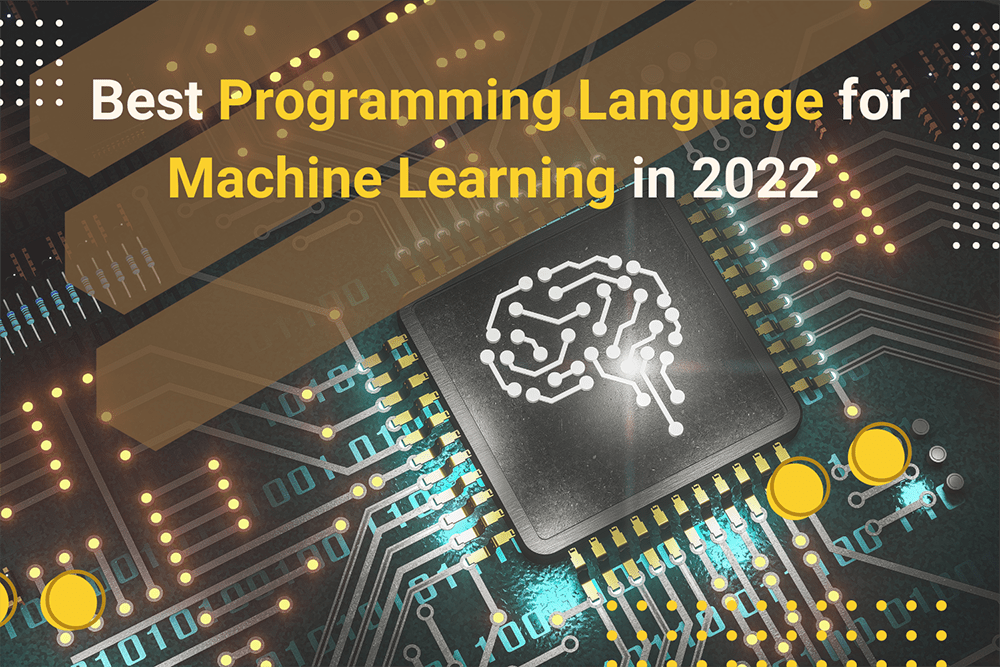Machine learning is a subset of artificial intelligence. It allows software programs to enhance their capacity to predict outcomes without being explicitly designed to do so. Machine learning algorithms use past data as input to anticipate new output values.
ML libraries let developers implement machine learning reasoning into their applications using specific programming languages.
Machine learning models may be built using a variety of programming languages.
In this article, we will be discussing the best programming languages for machine learning in 2022.
Python:

Python can power complex scripting and internet applications, making it an excellent choice for both novice and experienced developers. It was created in 1991 as a general-purpose programming language.
Python has long been a popular among developers because to its simplicity and ease of usage. It works with a number of frameworks and libraries. Python experts are in great demand since the language is one of the most used in machine learning, data analytics, and web development. Python is a popular programming language because it offers a variety of coding alternatives.
Because of their open-source nature and scalability, several visualization packages and crucial core libraries like as sklearn and seaborn are accessible. These powerful libraries simplify coding and allow machines to learn more.
Python supports object-oriented, functional, imperative, and procedural programming paradigms. When it comes to machine learning frameworks, TensorFlow and Scikit are both quite popular among Python developers.
Python is appropriate for:
- Prototyping
- Scientific computation
- Sentiment analysis
- Natural language processing
- Data science.
R Language:

R is a popular open-source data visualization-driven language for statistical computing and machine learning. It also includes a wealth of resources for developing machine learning applications.
R is used by analysts, statisticians, and data miners because it is simpler to learn than other programming languages. It has a command-line interface and many IDEs, as well as a variety of tools for managing libraries and creating better graphs.
It is a graphics-based language used by data scientists in major organisations, notably in the healthcare industry, to interpret graphs.
R may be used to implement Representational State Machines (RSMs) such as classification, regression, and decision tree creation. Because of its statistical and functional qualities, it has been a dynamic, imperative, and functional language. It can operate on various systems in addition to Windows, Linux, and OS X.
JavaScript – Java:

JavaScript and Java can help a variety of machine learning applications and methodologies. These languages are noted for their reliability and stability, and they are object-oriented and capable of handling large amounts of data.
There are sophisticated frameworks in Java for machine learning approaches like decision trees and regression, such as Weka and Rapid Miner.
Furthermore, Java is a fantastic choice for enterprise-level software. JavaScript, on the other hand, is employed in practically all front-end development projects by major organisations.
To be successful in machine learning applications, these technologies rely on the various machine learning libraries that are linked to them.
Some of the applications where JavaScript professionals employ these languages in machine learning include fraud detection, cyber-attack detection, and network security.
Scala:

While there are many programming languages in the world, Scala is gaining popularity due of machine learning. Scala’s executable code runs swiftly due to the usage of a well-known compiler. It provides a static system for interoperability with Java frameworks and libraries.
Scala is well-known for its ability to handle huge databases and provide scalable solutions in enterprise-level applications. Its capacity to develop large-scale, data-intensive applications is its distinguishing feature.
Scala’s MLLIB library delivers competitive functionality and is backed by the well-known Apache Spark framework. As a result, it can handle massive volumes of data.
Developers may construct, implement, and deploy machine learning algorithms using Spark and other big data tools and technologies. Scala has libraries such as Aerosol, Saddle, and others that can help with the creation of scientific computing, linear algebra, and other applications involving random number generation. These libraries provide a variety of data manipulation possibilities, including 2D data structures and automated data alignment.
Despite the fact that Scala is rarely the first language of choice, Java veterans may find it relatively straightforward to learn. As a result, hiring a Java developer who is eager to learn is frequently better to hiring someone with the requisite abilities from outside.
C/C++:

C/C++ programming languages are robust, versatile, and extensively used across the world. And there is no going back when it comes to building machine learning algorithms.
C, C++, Java, and Python have long dominated the developer community because they are routinely updated to stay up with the latest innovations.
Computers can read and understand these languages since they are considered low-level languages. Machine learning applications may be deployed on IoT devices since providing hardware-level functionality is straightforward.
These applications profit greatly from the ease with which they may be produced and deployed. Torch, TensorFlow, and other sophisticated libraries are all implemented in C/C++. They have proven useful in performance-critical situations.
C++ is the best programming language for changing algorithms and managing large amounts of memory. Using this language, developers may additionally fine-tune a wide range of performance variables.
Shell:
The Shell programming language was inspired by the Unix shell, a command-line interpreter.
Because of its simple syntax, Shell’s scripting languages and wrappers make it an excellent choice for constructing machine learning tools, algorithms, and apps.
Shell is a user interface for executing operations that gathers and prepares data using mathematical models. It supports all operating systems, including Windows, Linux, and Mac OS X.
Shell commands and scripts are used to collect data. It simplifies and enjoys data processing.


